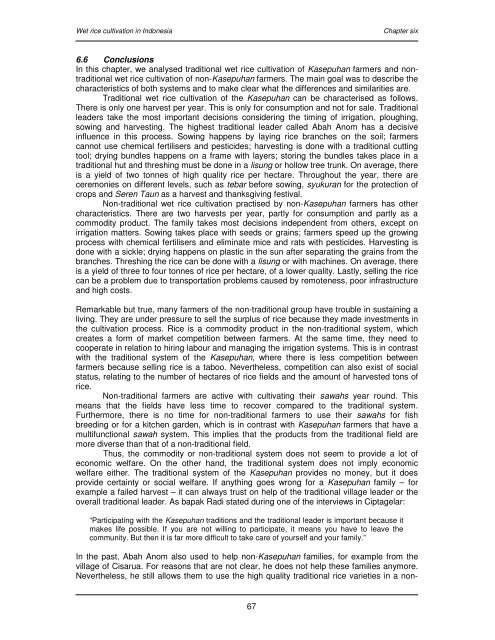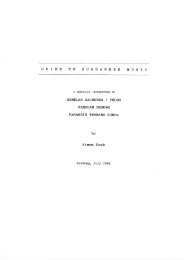Wet rice cultivation in Indonesia - Free EBooks Library
Wet rice cultivation in Indonesia - Free EBooks Library
Wet rice cultivation in Indonesia - Free EBooks Library
You also want an ePaper? Increase the reach of your titles
YUMPU automatically turns print PDFs into web optimized ePapers that Google loves.
<strong>Wet</strong> <strong>rice</strong> <strong>cultivation</strong> <strong>in</strong> <strong>Indonesia</strong> Chapter six<br />
6.6 Conclusions<br />
In this chapter, we analysed traditional wet <strong>rice</strong> <strong>cultivation</strong> of Kasepuhan farmers and nontraditional<br />
wet <strong>rice</strong> <strong>cultivation</strong> of non-Kasepuhan farmers. The ma<strong>in</strong> goal was to describe the<br />
characteristics of both systems and to make clear what the differences and similarities are.<br />
Traditional wet <strong>rice</strong> <strong>cultivation</strong> of the Kasepuhan can be characterised as follows.<br />
There is only one harvest per year. This is only for consumption and not for sale. Traditional<br />
leaders take the most important decisions consider<strong>in</strong>g the tim<strong>in</strong>g of irrigation, plough<strong>in</strong>g,<br />
sow<strong>in</strong>g and harvest<strong>in</strong>g. The highest traditional leader called Abah Anom has a decisive<br />
<strong>in</strong>fluence <strong>in</strong> this process. Sow<strong>in</strong>g happens by lay<strong>in</strong>g <strong>rice</strong> branches on the soil; farmers<br />
cannot use chemical fertilisers and pesticides; harvest<strong>in</strong>g is done with a traditional cutt<strong>in</strong>g<br />
tool; dry<strong>in</strong>g bundles happens on a frame with layers; stor<strong>in</strong>g the bundles takes place <strong>in</strong> a<br />
traditional hut and thresh<strong>in</strong>g must be done <strong>in</strong> a lisung or hollow tree trunk. On average, there<br />
is a yield of two tonnes of high quality <strong>rice</strong> per hectare. Throughout the year, there are<br />
ceremonies on different levels, such as tebar before sow<strong>in</strong>g, syukuran for the protection of<br />
crops and Seren Taun as a harvest and thanksgiv<strong>in</strong>g festival.<br />
Non-traditional wet <strong>rice</strong> <strong>cultivation</strong> practised by non-Kasepuhan farmers has other<br />
characteristics. There are two harvests per year, partly for consumption and partly as a<br />
commodity product. The family takes most decisions <strong>in</strong>dependent from others, except on<br />
irrigation matters. Sow<strong>in</strong>g takes place with seeds or gra<strong>in</strong>s; farmers speed up the grow<strong>in</strong>g<br />
process with chemical fertilisers and elim<strong>in</strong>ate mice and rats with pesticides. Harvest<strong>in</strong>g is<br />
done with a sickle; dry<strong>in</strong>g happens on plastic <strong>in</strong> the sun after separat<strong>in</strong>g the gra<strong>in</strong>s from the<br />
branches. Thresh<strong>in</strong>g the <strong>rice</strong> can be done with a lisung or with mach<strong>in</strong>es. On average, there<br />
is a yield of three to four tonnes of <strong>rice</strong> per hectare, of a lower quality. Lastly, sell<strong>in</strong>g the <strong>rice</strong><br />
can be a problem due to transportation problems caused by remoteness, poor <strong>in</strong>frastructure<br />
and high costs.<br />
Remarkable but true, many farmers of the non-traditional group have trouble <strong>in</strong> susta<strong>in</strong><strong>in</strong>g a<br />
liv<strong>in</strong>g. They are under pressure to sell the surplus of <strong>rice</strong> because they made <strong>in</strong>vestments <strong>in</strong><br />
the <strong>cultivation</strong> process. Rice is a commodity product <strong>in</strong> the non-traditional system, which<br />
creates a form of market competition between farmers. At the same time, they need to<br />
cooperate <strong>in</strong> relation to hir<strong>in</strong>g labour and manag<strong>in</strong>g the irrigation systems. This is <strong>in</strong> contrast<br />
with the traditional system of the Kasepuhan, where there is less competition between<br />
farmers because sell<strong>in</strong>g <strong>rice</strong> is a taboo. Nevertheless, competition can also exist of social<br />
status, relat<strong>in</strong>g to the number of hectares of <strong>rice</strong> fields and the amount of harvested tons of<br />
<strong>rice</strong>.<br />
Non-traditional farmers are active with cultivat<strong>in</strong>g their sawahs year round. This<br />
means that the fields have less time to recover compared to the traditional system.<br />
Furthermore, there is no time for non-traditional farmers to use their sawahs for fish<br />
breed<strong>in</strong>g or for a kitchen garden, which is <strong>in</strong> contrast with Kasepuhan farmers that have a<br />
multifunctional sawah system. This implies that the products from the traditional field are<br />
more diverse than that of a non-traditional field.<br />
Thus, the commodity or non-traditional system does not seem to provide a lot of<br />
economic welfare. On the other hand, the traditional system does not imply economic<br />
welfare either. The traditional system of the Kasepuhan provides no money, but it does<br />
provide certa<strong>in</strong>ty or social welfare. If anyth<strong>in</strong>g goes wrong for a Kasepuhan family – for<br />
example a failed harvest – it can always trust on help of the traditional village leader or the<br />
overall traditional leader. As bapak Radi stated dur<strong>in</strong>g one of the <strong>in</strong>terviews <strong>in</strong> Ciptagelar:<br />
“Participat<strong>in</strong>g with the Kasepuhan traditions and the traditional leader is important because it<br />
makes life possible. If you are not will<strong>in</strong>g to participate, it means you have to leave the<br />
community. But then it is far more difficult to take care of yourself and your family.”<br />
In the past, Abah Anom also used to help non-Kasepuhan families, for example from the<br />
village of Cisarua. For reasons that are not clear, he does not help these families anymore.<br />
Nevertheless, he still allows them to use the high quality traditional <strong>rice</strong> varieties <strong>in</strong> a non-<br />
67








